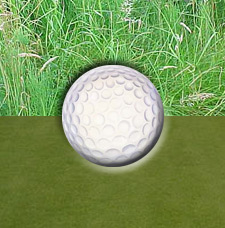Chipping Club Selection Based on Lie Many golfers hear the term "chip" and automatically reach into their bag to pull out their pitching wedge. Don't get me wrong, I don't think their is ANY type of chip or pitch that could not be turned into a successful shot by using a pitching wedge. The pitching wedge is an absolute utility club, however you may find better results using "specialized" chipping clubs such as a sand wedge, lobb wedge, or other club. Many golfers hear the term "chip" and automatically reach into their bag to pull out their pitching wedge. Don't get me wrong, I don't think their is ANY type of chip or pitch that could not be turned into a successful shot by using a pitching wedge. The pitching wedge is an absolute utility club, however you may find better results using "specialized" chipping clubs such as a sand wedge, lobb wedge, or other club.
The type of lie and desired shot should really determine the club you use to chip when around the green: Lobb wedge: I love chipping with my lobb wedge. It's just a regular lobb wedge, not a high lobb wedge, but I still get plenty of loft out of it. When I hit it just right, the ball floats effortlessly in the air, hits the green nice and soft, and usually has some backspin. The problem is that I (like many other golfers I've played with and talked to), have a difficult time hitting a successful lobb wedge shot unless I am taking a full swing. I find that because of the high angle, it's usually an "all-or-nothing" when the clubface makes contact with the ground. If I'm too far under the ball or behind it when I strike the ground, I'll usually end up with a two-inch thick divot that's about a foot long. The club face just drags and gets "stuck" in the ground. I also have a difficult time hitting my lobb wedge out of rough, in high grass, or when the ball is burried or beside a divot, etc. Because of these reasons, I usually reserve my lobb wedge chip shot for when I am on the fairway, with a great lie, and am far enough (15-30 yards or more) that I can take a pretty decent swing. Sand wedge: Sand wedge shots are closer in arc and characteristics to pitching wedge chip shots than lobb wedge shots. I could almost interchange my sand wedge and pitching wedge when chipping and not notice a difference. The main difference though is in the arc. If I need to get over a sand bunker, or the pin is closer to the front of the green, I will use my sand wedge as it produces a slightly higher arc than a pitching wedge. I'll also use my sand wedge if I want more of a lobb wedge arc, but have a worse-than-fairway lie. Pitching wedge: The pitching wedge is the go-to club when chipping. Unless you have a great lie or are looking for more arc, the pitching wedge is the way to go. Depending on how you hold the club, your stance, etc. you can hit anything from a low line drive to a high-arcing flop shot. If you find yourself in the rough around the green, use your pitching wedge. If you are more than 30-40 yards out, use your pitching wedge. If your ball is next to or in a divot or in a bad lie, use your pitching wedge. If the pin is towards the back of the green and you want the ball to roll a decent amount, use your pitching wedge. In short, your pitching wedge is your utility chipping club and should be mastered before moving on to some of the other "specialty" clubs. Other clubs: There is another article on this site about using other clubs besides a pitching wedge when chipping, and so I'll just briefly mention the benefits. When chipping you have every club at your disposal. Imagine the type of shot your 5 iron produces and try to visualize that same arc and trajectory toned down for a chip. If that type of shot suits your situation, go with it! Technorati Tags: golf chipping golf tips golf instruction pitching short game |

|
|
